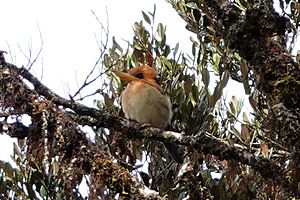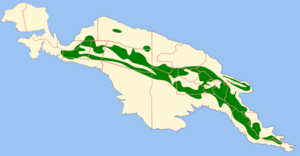Mountain kingfisher facts for kids
Quick facts for kids Mountain kingfisher |
|
|---|---|
 |
|
| Conservation status | |
| Scientific classification | |
| Genus: |
Syma
|
| Species: |
megarhyncha
|
| Subspecies | |
|
|
 |
|
| Synonyms | |
|
|
The mountain kingfisher (Syma megarhyncha) is a colorful bird found only in New Guinea. It belongs to the kingfisher family, known for their bright feathers and fishing skills. This bird is about 21 to 24 centimeters (8 to 9 inches) long.
Mountain kingfishers have a reddish-brown head and belly. Their upper body is greenish-blue, and their tail is dark blue. They also have black patches on their neck and near their eyes. Female mountain kingfishers have a black crown on their head, and their neck patches connect at the back of their neck. This bird looks a bit like the yellow-billed kingfisher, but it's bigger and has a larger beak with a dark line on top.
You can find these kingfishers in the high mountain areas of New Guinea, living in moist forests. They usually live at elevations between 1,200 and 2,400 meters (about 3,900 to 7,900 feet) above sea level. They mostly eat small lizards, insects, and insect larvae.
Contents
What the Mountain Kingfisher Looks Like
The mountain kingfisher is a small bird. Males usually weigh between 52 and 60 grams (1.8 to 2.1 ounces), and females weigh between 49 and 63 grams (1.7 to 2.2 ounces). Both males and females are about 21 to 24 centimeters (8 to 9 inches) long.
Males have a reddish-brown head and belly. Their back and wings are greenish-blue. They have black patches near their eyes and on the back of their neck. Their tail is dark blue, and their wing feathers are black with blue edges.
Female mountain kingfishers have a black crown on their head. Their belly is a bit lighter in color than the males'. A cool thing about females is that their neck patches join together, forming a black bar across the back of their neck.
The beak of the mountain kingfisher is bright yellow, but it has a dark line along the top ridge. Their eyes are dark brown, and their legs and feet are a dull yellow color. Young kingfishers have a grayish-black beak and dark spots around their ears. They also have more black around their eyes and dark tips on the feathers of their cheeks and chest.
The yellow-billed kingfisher is similar, but it has an all-yellow beak and lives in lower areas. The mountain kingfisher is also larger with a bigger beak.
Sounds They Make
Mountain kingfishers often call out from the tops of trees. They make a loud, whistling, trilling sound. This call usually has 3 to 4 trills that go down in pitch, with short pauses in between. The song ends with a special trill that drops, then rises, and then drops again in pitch. Their calls are deeper than those of the yellow-billed kingfisher.
Where They Live
The mountain kingfisher lives only on the island of New Guinea. You can find them in most of the high mountain regions there, except for one area called the Bird's Head peninsula.
These birds prefer to live in forests, both old-growth forests and areas where new trees are growing back. They are usually found at higher elevations, typically between 1,200 and 2,400 meters (about 3,900 to 7,900 feet) above sea level. Sometimes, they are seen as low as 700 meters (about 2,300 feet). At lower elevations, their place is taken by the yellow-billed kingfisher.
What They Eat and How They Live
The mountain kingfisher mainly eats small lizards, insects, and insect larvae. They hunt by sitting quietly on a branch in the middle or upper parts of the trees for a long time. When they spot prey, they quickly dive down to catch it.
Reproduction and Life Cycle
Mountain kingfishers dig their nests into earthen riverbanks or dry wood. In Papua New Guinea, they lay their eggs in December. They usually lay two white eggs at a time.
How We Protect Them
Scientists haven't counted the exact number of mountain kingfishers. However, because they live across a fairly large area and their population seems stable, the IUCN lists them as a "least concern" species. This means they are not currently at high risk of disappearing. While they might be rare in some places, they are quite common in others across New Guinea.


